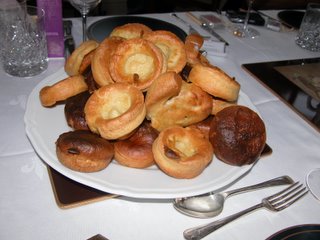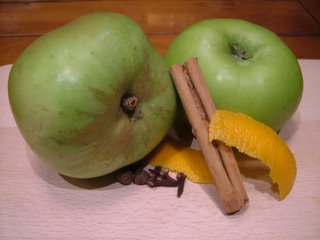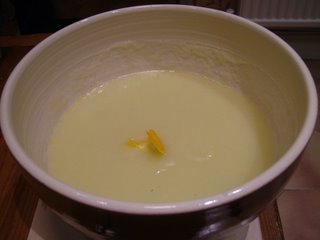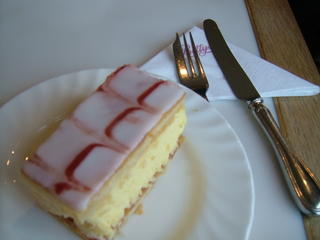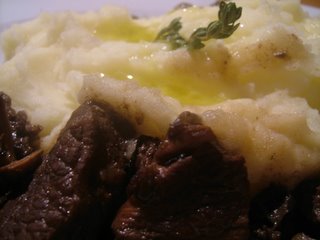 Update, Feb 2008: Lots of people have asked me if you can freeze mashed potatoes. The answer’s complicated – mash will freeze, but it won’t be as good as it was fresh (it tends to change texture in a watery direction and lose some of its flavour). However (there’s always a however), if you want to have some spare mash kicking around to top shepherd’s pie, thicken soups or use as a base for fishcakes, it’s worth freezing individual portions to use in these recipes if you have some left over. Heat the portions for a while in a saucepan once defrosted to evaporate out some of the water before using.
Update, Feb 2008: Lots of people have asked me if you can freeze mashed potatoes. The answer’s complicated – mash will freeze, but it won’t be as good as it was fresh (it tends to change texture in a watery direction and lose some of its flavour). However (there’s always a however), if you want to have some spare mash kicking around to top shepherd’s pie, thicken soups or use as a base for fishcakes, it’s worth freezing individual portions to use in these recipes if you have some left over. Heat the portions for a while in a saucepan once defrosted to evaporate out some of the water before using.
Mashed potatoes are probably my favourite comfort food. One of my earliest memories is that of my mother coaxing me away from the brink of death by measles with plain mashed potatoes and a little gravy. The mashed potatoes I dream about are not mashed potatoes spiked with mustard or garlic; no pesto colours them bright green for me. I like my mashed potatoes spiced gently with black pepper and nutmeg, and with plenty of salt. Some cooks will tell you to use white pepper for aesthetic reasons; I see nothing wrong with a few black specks in my mash, especially given that freshly ground black pepper tastes so much better in this dish than white does.
The potato you choose is important. Potato varieties can be split into two groups – waxy and floury. Waxy potatoes keep their shape well when cooked and are excellent in gratins – they remain quite moist when cooked. A floury potato cooks to a drier, more fluffy finish, doesn’t hold its shape well, and should be your potato of choice for mashing.
My great-grandma used to mash potatoes to lump-free perfection with a fork. God knows how. I use a bog-standard potato masher. Excellent results can be reliably achieved with a potato ricer, which sort of extrudes the cooked potato through tiny holes. Regular readers will know that I’m always chary about buying single-use devices, so I stick to my masher, which also gets used for other generalised vegetable-squashing tasks.
Whatever you do, don’t use a food processor. I am not quite sure about the physics behind this, but any high-intensity processing of the sort you get with a Magimix makes the potatoes very slimy and not very appetising.
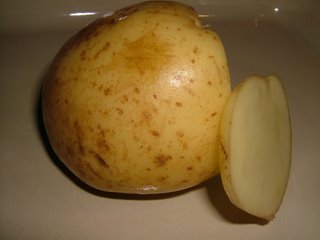 King Edwards, Saxon, Estime or Nadine potatoes all mash well; they’re floury and flavourful. The technique is all-important; whipping scalding hot milk into your dry mash will make the mixture silky and fluffy, and a large knob of butter adds richness. To serve four, you’ll need:
King Edwards, Saxon, Estime or Nadine potatoes all mash well; they’re floury and flavourful. The technique is all-important; whipping scalding hot milk into your dry mash will make the mixture silky and fluffy, and a large knob of butter adds richness. To serve four, you’ll need:
700g potatoes, peeled and cut into evenly sized chunks
¼ pint full cream milk
1 large knob butter
Salt and pepper
Freshly grated nutmeg
Simmer the potatoes in boiling water with the lid on for about 20 minutes, until you can easily push a knife through the centre of one. Drain and return to the pan, and put down somewhere warm with the lid on for five minutes while you bring the milk up to a gentle simmer. Drop the butter into the middle of the pan with the salt, generous grindings of pepper and some freshly ground nutmeg, and mash vigorously until there are no lumps. (You’ll find the potatoes are best with a surprisingly large amount of salt, but I like potatoes better than my arteries.)
Hold the milk pan in your left hand and a wooden spoon in your right, and pour the milk into the mashed potatoes in a thin stream, beating it in with the wooden spoon. Serve immediately – these will be the creamiest, most delicate mashed potatoes you’ve ever eaten. If you’ve any left over, keep them in the fridge and make fishcakes tomorrow.

